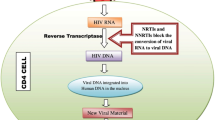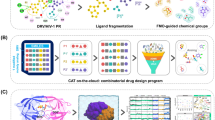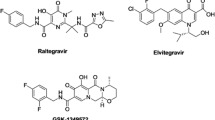Abstract
The intense research on small molecule inhibitors of Human immunodeficiency virus (HIV)-protease (PR) has produced a diverse class of chemical scaffolds which includes clinically available HIV PR inhibitors (PRI). Till now, these inhibitors are insignificant for targeting proteolytic activity and few drug molecules on alterations can enhance the inhibition of PR enzyme. Here, we developed a method for screening of new hits from Cambridge structural database, based on binding mode of indinavir interaction participating atoms. Knowledge-based ligand screening technique approximately informs that new hits are also having same binding mode-like indinavir interaction patterns. Considering the importance of ligand fitting in binding pocket, we developed induced-fit models for each compound and we obtained accurate energy values in terms of binding and interaction energy. We found that newly search molecules are interacting better than known drug—indinavir and these new compounds are comparatively having better drug-like property. Finally, we demonstrated that pocket specific docking, energy utilization, interactions, and ADME for screened compounds are showing new hit compounds of indinavir are better HIV PRI and these new compounds can also show better activity in in vivo and in vitro conditions.




Similar content being viewed by others
Abbreviations
- CSD:
-
Cambridge structural database
- OPLS:
-
Optimized potential for liquid simulation
- IFD:
-
Induced-fit docking
- PR:
-
Protease
- PRI:
-
Protease inhibitor
References
Adachi M, Ohhara T, Kurihara K, Tamada T, Honjo E, Okazaki N, Arai S, Shoyama Y, Kimura K, Matsumura H, Sugiyama S, Adachi H, Takano K, Mori Y, Hidaka K, Kimura T, Hayashi Y, Kiso Y, Kuroki R (2009) Structure of HIV-1 protease in complex with potent inhibitor KNI-272 determined by high-resolution X-ray and neutron crystallography. Proc Natl Acad Sci USA 106:4641–4646
Alfonso Y, Monzote L (2011) HIV protease inhibitors: effect on the opportunistic protozoan parasites. Open Med Chem J 5:40–50
Allen FH (2002) The Cambridge structural database: a quarter of a million crystal structures and rising. Acta Crystallogr B 58:380–388
Aslani AA, Mangematin V (2009) The future of drug discovery and development: shifting emphasis towards personalized medicine. Technol Forecast Soc Chang 77:203–217
Battle GM, Ferrence GM, Allen FH (2010) Applications of the Cambridge structural database in chemical education. J Appl Crystallogr 43:1208–1223
Bissantz C, Kuhn B, Stahl M (2010) A medicinal chemist’s guide to molecular interactions. J Med Chem 53:5061–5084
Boyd M (2007) Indinavir: the forgotten HIV-protease inhibitor. Does it still have a role? Expert Opin Pharmacother 8:957–964
Bruno IJ, Cole JC, Edgington PR, Kessler M, Macrae CF, McCabe P, Pearson J, Taylor R (2002) New software for searching the Cambridge structural database and visualizing crystal structures. Acta Crystallogr B 58:389–397
Chen IJ, Foloppe N (2010) Drug-like bioactive structures and conformational coverage with the LigPrep/ConfGen suite: comparison to programs MOE and catalyst. J Chem Inf Model 50:822–839
Cooper CL, van Heeswijk RP, Gallicano K, Cameron DW (2003) A review of low-dose ritonavir in protease inhibitor combination therapy. Clin Infect Dis 36:1585–1592
Das D, Koh Y, Tojo Y, Ghosh AK, Mitsuya H (2009) Prediction of potency of protease inhibitors using free energy simulations with polarizable quantum mechanics-based ligand charges and a hybrid water model. J Chem Inf Model 49:2851–2862
Gayathri P, Pande V, Sivakumar R, Gupta SP (2001) A quantitative structure-activity relationship study on some HIV-1 protease inhibitors using molecular connectivity index. Bioorg Med Chem 9:3059–3063
Jelsch C, Teeter MM, Lamzin V, Pichon-Pesme V, Blessing RH, Lecomte C (2000) Accurate protein crystallography at ultra-high resolution: valence electron distribution in crambin. Proc Natl Acad Sci USA 97:3171–3176
Jiang JK, Ghoreschi K, Deflorian F, Chen Z, Perreira M, Pesu M, Smith J, Nguyen DT, Liu EH, Leister W, Costanzi S, O’Shea JJ, Thomas CJ (2008) Examining the chirality, conformation and selective kinase inhibition of 3-((3R,4R)-4-methyl-3-(methyl(7H-pyrrolo[2,3-d]pyrimidin-4-yl)amino)piperidin-1-yl)-3-oxopropanenitrile (CP-690,550). J Med Chem 51:8012–8018
Jorgensen WL, Duffy EM (2002) Prediction of drug solubility from structure. Adv Drug Deliv Rev 54:355–366
Khedkar VM, Ambre PK, Verma J, Shaikh MS, Pissurlenkar RR, Coutinho EC (2010) Molecular docking and 3D-QSAR studies of HIV-1 protease inhibitors. J Mol Model 16:1251–1268
Klebe G, Krämer O, Sotriffer C (2004) Strategies for the design of inhibitors of aldose reductase, an enzyme showing pronounced induced-fit adaptations. Cell Mol Life Sci 61:783–793
Kurup A, Mekapati SB, Garg R, Hansch C (2003) HIV-1 protease inhibitors: a comparative QSAR analysis. Curr Med Chem 10:1679–1688
Loizidou EZ, Zeinalipour-Yazdi CD, Christofides T, Kostrikis LG (2009) Analysis of binding parameters of HIV-1 integrase inhibitors: correlates of drug inhibition and resistance. Bioorg Med Chem 17:4806–4818
Lyne PD, Lamb ML, Saeh JC (2006) Accurate prediction of the relative potencies of members of a series of kinase inhibitors using molecular docking and MM-GBSA scoring. J Med Chem 49:4805–4808
Menendez-Arias L (2002) Targeting HIV: antiretroviral therapy and development of drug resistance. Trends Pharmacol Sci 23:381–388
Miller JF, Brieger M, Furfine ES, Hazen RJ, Kaldor I, Reynolds D, Sherrill RG, Spaltenstein A (2005) Novel P1 chain-extended HIV protease inhibitors possessing potent anti-HIV activity and remarkable inverse antiviral resistance profiles. Bioorg Med Chem Lett 15:3496–3500
Mobley DL, Dill KA (2009) Binding of small-molecule ligands to proteins: “what you see” is not always “what you get”. Structure 17:489–498
Mouchlis VD, Mavromoustakos TM, Kokotos G (2010) Molecular docking and 3D-QSAR CoMFA studies on indole inhibitors of GIIA secreted phospholipase A(2). J Chem Inf Model 50:1589–1601
Perryman AL, Zhang Q, Soutter HH, Rosenfeld R, McRee DE, Olson AJ, Elder JE, Stout CD (2010) Fragment-based screen against HIV protease. Chem Biol Drug Des 75:257–268
Provost P, Barat C, Plante I, Tremblay MJ (2006) HIV-l and the micro RNA-guided silencing pathway: an intricate and multifaceted encounter. Virus Res 121:107–115
Reddy KK, Singh SK, Dessalew N, Tripathi SK, Selvaraj C (2011) Pharmacophore modelling and atom-based 3D-QSAR studies on N-methyl pyrimidones as HIV-1 integrase inhibitors. J Enzyme Inhib Med Chem. doi:10.3109/14756366.2011.590803
Richman DD (2011) Introduction: challenges to finding a cure for HIV infection. Curr Opin HIV AIDS 6:1–3
Sengupta D, Verma D, Naik PK (2007) Docking mode of delvardine and its analogues into the p66 domain of HIV-1 reverse transcriptase: screening using molecular mechanics-generalized born/surface area and absorption, distribution, metabolism and excretion properties. J Biosci 32:1307–1316
Wang H, Aslanian R, Madison VS (2008) Induced-fit docking of mometasone furoate and further evidence for glucocorticoid receptor 17alpha pocket flexibility. J Mol Graph Model 27:512–521
Waszkowycz B, Clark DE, Gancia E (2011) Outstanding challenges in protein–ligand docking and structure-based virtual screening. Wiley Interdiscip Rev 1:229–259
Wu X, Ohrngren P, Ekegren JK, Unge J, Unge T, Wallberg H, Samuelsson B, Hallberg A, Larhed M (2008) Two-carbon-elongated HIV-1 protease inhibitors with a tertiary-alcohol-containing transition-state mimic. J Med Chem 51:1053–1057
Wu G, Vashishtha SC, Erve JC (2010) Characterization of glutathione conjugates of duloxetine by mass spectrometry and evaluation of in silico approaches to rationalize the site of conjugation for thiophene containing drugs. Chem Res Toxicol 16(8):1393–1404
Zavodszky MI, Kuhn LA (2005) Side-chain flexibility in protein-ligand binding: the minimal rotation hypothesis. Protein Sci 14:1104–1114
Acknowledgments
Authors of the study, Chandrabose Selvaraj and Sunil Kumar Tripathi thanking the Alagappa University (AURF) and Department of Science and Technology (DST), New Delhi, for the research fellowship and facility provided for this study. The authors thank an anonymous referee for the valuable suggestion.
Author information
Authors and Affiliations
Corresponding author
Electronic supplementary material
Below is the link to the electronic supplementary material.
Rights and permissions
About this article
Cite this article
Selvaraj, C., Singh, S.K., Tripathi, S.K. et al. In silico screening of indinavir-based compounds targeting proteolytic activity in HIV PR: binding pocket fit approach. Med Chem Res 21, 4060–4068 (2012). https://doi.org/10.1007/s00044-011-9941-5
Received:
Accepted:
Published:
Issue Date:
DOI: https://doi.org/10.1007/s00044-011-9941-5




